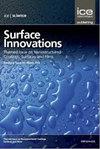Fabrication of sustainable radiative cooling film with superhydrophobic self-cleaning property
IF 3.5
4区 材料科学
Q3 CHEMISTRY, PHYSICAL
引用次数: 3
Abstract
Radiative cooling materials can cool terrestrial objects without any energy input, but are susceptible to rain wetting and dust contamination which affects badly the cooling characteristics. Herein, this work fabricated a radiative cooling porous film with superhydrophobic self-cleaning using poly (vinylidene fluoride-co-hexafluoropropylene) (PVDF-HFP) and poly (vinylidene fluoride) (PVDF). The PVDF-HFP/PVDF film consists of micropores with nanoparticles both inside and at the surface. The micro/nanostructures enhanced the scattering of solar light, which in combination with the infrared emissivity of both PVDF-HFP and PVDF polymers makes the film show excellent radiative cooling ability with a sub-ambient temperature drop of 16°C. The micro/nanostructures roughened the surface of the film, which in combination with the low surface energy property of both PVDF-HFP and PVDF polymers endows the film with superhydrophobic self-cleaning property. The self-cleaning function defends the film from contamination and maintain sustainable radiative cooling for lasting applications. The integration of cooling and self-cleaning into a film paves a way to multifunctional and long-life radiative cooling materials.具有超疏水自清洁性能的可持续辐射冷却膜的制备
辐射冷却材料可以在没有任何能量输入的情况下冷却陆地物体,但易受雨水润湿和灰尘污染的影响,这严重影响了冷却特性。在此,本工作使用聚偏二氟乙烯-共-六氟丙烯(PVDF-HFP)和聚偏二氟乙烯(PVDF)制备了具有超疏水自清洁的辐射冷却多孔膜。PVDF-HFP/PVDF薄膜由微孔组成,微孔内部和表面都有纳米颗粒。微/纳米结构增强了太阳光的散射,这与PVDF-HFP和PVDF聚合物的红外发射率相结合,使薄膜显示出优异的辐射冷却能力,亚环境温度下降16°C。微/纳米结构使薄膜表面粗糙化,这与PVDF-HFP和PVDF聚合物的低表面能特性相结合,赋予了薄膜超疏水自清洁性能。自清洁功能保护薄膜免受污染,并保持可持续的辐射冷却,以实现持久的应用。将冷却和自清洁整合到薄膜中,为多功能、长寿命的辐射冷却材料铺平了道路。
本文章由计算机程序翻译,如有差异,请以英文原文为准。
求助全文
约1分钟内获得全文
求助全文
来源期刊

Surface Innovations
CHEMISTRY, PHYSICALMATERIALS SCIENCE, COAT-MATERIALS SCIENCE, COATINGS & FILMS
CiteScore
5.80
自引率
22.90%
发文量
66
期刊介绍:
The material innovations on surfaces, combined with understanding and manipulation of physics and chemistry of functional surfaces and coatings, have exploded in the past decade at an incredibly rapid pace.
Superhydrophobicity, superhydrophlicity, self-cleaning, self-healing, anti-fouling, anti-bacterial, etc., have become important fundamental topics of surface science research community driven by curiosity of physics, chemistry, and biology of interaction phenomenon at surfaces and their enormous potential in practical applications. Materials having controlled-functionality surfaces and coatings are important to the manufacturing of new products for environmental control, liquid manipulation, nanotechnological advances, biomedical engineering, pharmacy, biotechnology, and many others, and are part of the most promising technological innovations of the twenty-first century.
 求助内容:
求助内容: 应助结果提醒方式:
应助结果提醒方式:


